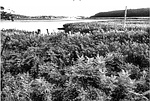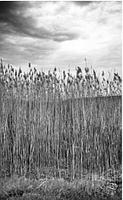Piermont Marsh Invaded by Aliens Live in Peace or Nuke ‘Em?
The building of the new Tappan Zee Bridge requires dredging of the river bottom for the construction of pylons to support two new spans. The degree of damage this dredging will inflict on the local ecosystem is not precisely known, but what is known is that the dredging project is the largest in the history of the Hudson.
To mitigate the impact, The New York State Department of Environmental Conservation (NYS DEC) is proposing to implement a number of reparative projects: studying the wintering habits of sturgeon and restoring the river bottom on which they depend for food and life cycle phases; restoring thirteen acres of hard bottom/shell oyster beds; restoring the natural flow of the Crumkill Creek by closing in the oxbow by-pass; improving the quality of storm water entering from Sparkill Creek; removing landfill at the north edge of Piermont Marsh where the ball park is located; and eradicating 90% of invasive phragmites australis over more than 200 acres of marshland through the application of herbicides to permit the reestablishment of historical plant species.
Phragmites australis, a vigorous plant that looks very like its native varietal, is the dense marsh grass that covers much of the meadow of the Piermont flats, lines the road out to the Piermont pier, and grows in the gutters along the lanes of Palisades. Its delicate mauve tassels spread invisible seeds that choke out native plants and reduce or transform biodiversity in waterfowl and fish populations.
The residents of Piermont, especially those living on Paradise Avenue, Gair Street, and in Bogertown, welcome most of what the NYS DEC proposes but are deeply concerned about the proposal to spray herbicides on the marsh. Palisades, located at the southern tip of the approximately 400 acre flat, will be downwind of herbicide application.
Marthe Schulwolf of the Piermont Marsh Alliance (PMA) stepped out onto her balcony the other day to demonstrate how close her home is to the marsh. Swaying grasses abutted the edge of her small backyard and extended as far as Snedens Landing. Hundreds of startled blackbirds rose in a cloud off the marsh meadow.
She noted the irony in the NYS DEC’s having recently presented to the Piermont Landing Homeowners’ Association the NYS Governor’s Award for Pollution Prevention for their work in using only organic methods for landscaping, and now the NYS DEC is proposing to use a toxic chemical solution very near human habitation on a problem that not everyone agrees exists.
Schulwolf and her neighbors formed the PMA to argue the case that the grasses should be left alone— that they are not harmful enough to warrant the application of herbicide. The herbicide likely to be used is glyphosate, the active ingredient in Round- Up, and has been shown to cause birth defects, infertility, and cancer in laboratory animals. There are anecdotal accounts of colony collapse disorder in honeybees occurring in temporal relation to aerial crop spraying of glyphosate. It is known to be toxic to many species, including those that currently make their home in the marsh. The state contends that the chemical would be hand sprayed from a boat on windless days, but the residents along the marsh know such days are rare. In any case, the herbicide would kill not only phragmites, but all plant species, thereby destroying the habitat of large numbers of birds and fish.
The plan calls for a pilot spray of a few acres, and after consideration of the results, subsequent applications in larger and larger areas until about 200 acres are treated. It is estimated from experience in other wetlands that it would take about five years for native species to grow in. Erosion during the transition period would be mitigated by the use of coin berms. The eradication project would likely require frequent respraying, since the grass thrives all around us and there is nothing else to prevent its return.
F. A. Montalto, et al, write in the Journal of Hydrology that wetlands serve as a transitional zone between uplands and estuaries, mediating the exchange of sediments, nutrients, organic matter and pollutants between terrestrial and aquatic ecosystems. They stabilize shorelines and attenuate tidal surges. They are feeding, breeding and resting grounds for resident and migratory fish and fowl, and host unique vegetative and microbial communities. They are among the most prolific converters of sunlight into organic matter in the world.
Piermont Marsh is one of four tidal marshes that constitute the Hudson River National Estuarine Research Reserve. Core sampling shows that the marsh is composed of layers of peats and clays at least as far deep as eleven meters. As of 2006, about three fourths of the surface of the marsh were covered by phragmites australis with an interior marked by diverse vegetation, including spartina alterniflora, or salt hay. Spartina was the dominant plant on the east side of the marsh as recently as 1967 and cattail was dominant adjacent to the Palisades escarpment.
Although evidence points to the existence of Phragmites australis in the southwest of the North American continent for 40,000 years, it is thought to have come to the Atlantic coast from Europe in the form of packing material for ships’ cargo. Points of entry appear to cluster around Boston, New York, and New Orleans. It quickly established itself over the last 150 years in coastal wetlands and proved its adaptability by moving into drier ground along roadsides and into the Midwest, and is found nearly everywhere including southern Canada. The grass’s explosive spread is thought to be related to human activities that stress the wetland environment such as pollution, changes in water quality and tidal action, and increased soil salinity.
P. australis’ perceived harmfulness depends on where you live: in Europe, where it appears to be dying out, efforts are underway to rejuvenate it, and in California, it is being actively planted for its positive qualities, which, surprisingly, are numerous. When compared to native varietals, phragmites australis performs superiorly in isolating lead underground in its corms or root system. It also is a better barrier against tidal surges—there is less erosion of the coastline wherever p. australis is prevalent. It’s an efficient cleanser of polluted water and there are two outflows of treated and untreated sewage into the marsh. P. australis is a vital food source for insects and the birds that feed on them, and for fish, crabs and other forms of water life. Marsh wrens, woodpeckers, robins, cardinals, finch, warblers, and waterfowl as varied as kingfishers, mute swans, gulls, loons, grebes, herons, teal, coots, cormorants, and sandpipers— all nest or rest on their migrations in the Piermont Marsh. Rather than reduce biodiversity, it appears to shift it so that the marsh now hosts a vibrant and complex, though different, ecosystem.
The Piermont Marsh Association has met with the NYS DEC and presented their position for leaving the marsh alone, including not disturbing the capped landfill at the ballpark. The NYS DEC has asked them in turn to propose an alternative project that the community would accept. The PMA is putting forward the study and clean-up of Sparkill Creek.
Dr. Dorothy Peteet, who has studied the marsh with the Lamont-Doherty Earth Observatory, was reported by Our Town to say that she and others at Lamont agree that the NYS DEC needs to do a lot more research before they spray and they probably shouldn’t spray at all. Marthe Schulwolf, paraphrasing Judith Weis, PhD, a biologist and Professor Emerita from Rutgers University, says that if you want to eradicate an invasive species, you might want to look in the mirror before you wage war on other forms of life.
For more information on phragmitis management, go to www.hudsonia.org. To get involved, email your contact information to PiermontMarshAlliance@verizon.net



